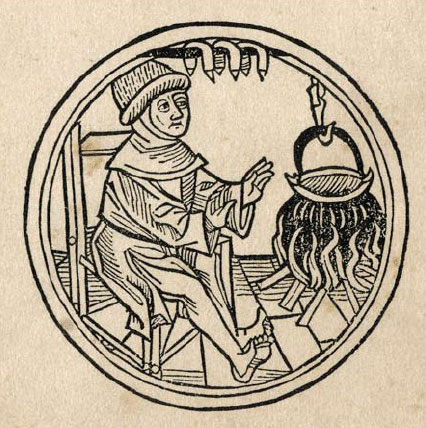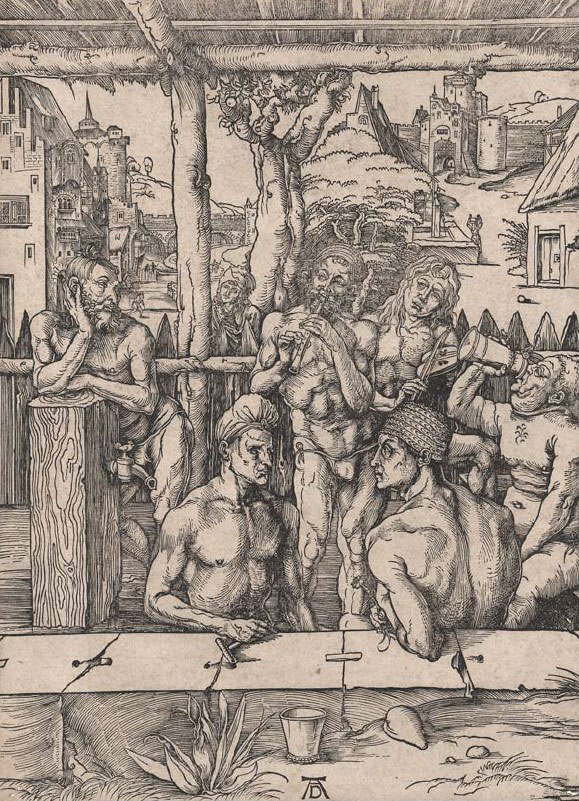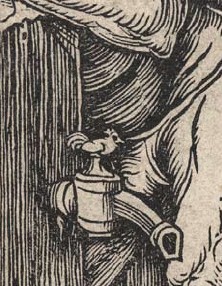- Relief printing
- Intaglio and planographic printing
- Color printing
- Bits and pieces
- Early photography in silver
- Non-silver processes
- Modern photography
- Color notes
- Color photography
- Photography in ink: relief and intaglio printing
- Photography in ink: planographic printing
- Digital processes
- Where do we go from here?
Creating Tone in Woodcut

Woodcut. Artist unknown. February from German Calendar. c. 1484. 3 5/8 x 3 1/2" (9.2 x 8.9 cm). The Museum of Modern Art, New York. Gift of Richard Benson.
The picture has been made with a woodblock. The image is not a unique drawing but the visual record of a carving in a flat wooden plank. Those areas that were not intended to print were carved away, and the remaining surface of the wood, after being inked, transferred the image to a sheet of paper. The design of the picture is fundamentally linear. The use of lines as descriptive tools, found as far back as the cave paintings, is perhaps the most remarkable innovation in the entire history of picture-making. While lines appear in nature in many forms—from blades of grass to winding rivers—in pictorial terms they are completely artificial. In life the leg and foot of the person we see here are soft and rounded; the lines that describe them in the picture are artificial, yet their meaning is absolutely clear.

Woodcut. Albrecht Dürer. The Men’s Bath. c. 1496. 15 7/16 x 11 3/16" (39.2 x 28.4 cm). Collection of John Benson. Printers have had to devise methods of creating tonal variation using only black ink. One solution is to use finely spaced lines that, though black, give the eye the illusion of tone when viewed from a distance.
There must be some remarkable circuitry in our brains that we can so effortlessly see the lines and imagine the object. Relief printing is so named because the image-bearing part of the printing matrix—in this case a wooden block—stands higher than those areas that do not print. The woodblock is made by carving, with a chisel or gouge, into the side of a hard plank. Once carved, the block is inked, either with a roller covered in an even layer of ink or with an ink-covered rag applied with care to deposit ink on the high surfaces only. Since the sunken, cut-away areas receive no ink and are in any case kept away from the paper by the higher parts of the surface, they appear white in the print.
 Detail of Woodcut. Albrecht Dürer. The Men’s Bath. c. 1496. 15 7/16 x 11 3/16" (39.2 x 28.4 cm). Collection of John Benson. A detail enlarged about 1.2 times from the original print.
Detail of Woodcut. Albrecht Dürer. The Men’s Bath. c. 1496. 15 7/16 x 11 3/16" (39.2 x 28.4 cm). Collection of John Benson. A detail enlarged about 1.2 times from the original print.
Conversely, the lines and solids we see in the print were printed by the parts that were not carved; each has had material removed along its sides and remains as the high part of the block, still possessing its original surface. It is ironic that what we see as a black line is actually the part of the block that the carver never touched. In our Dürer print the quality of the carving is remarkable. The dense array of carved channels and raised lines in the block represent a high point in the wood-carver’s trade. When the print is seen from only a short distance away the eye blends the lines and spaces to read variable tone, and so the challenge of achieving the illusion of tone, and with it of volume and perspective, is elegantly solved.

